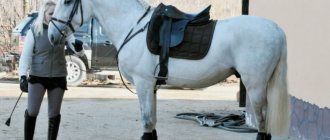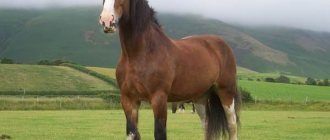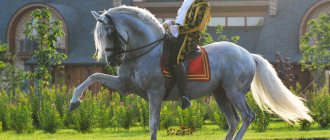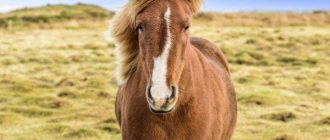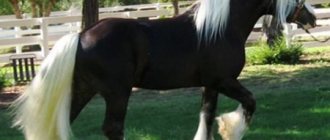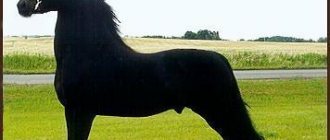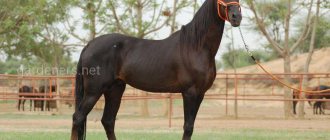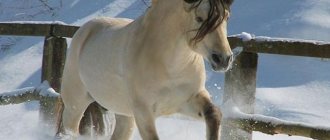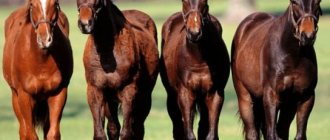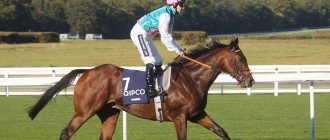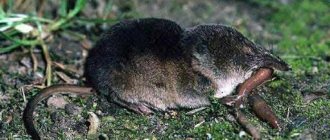The American Trotter is a breed of horse considered to be the fastest. These horses played a special role in the formation of domestic, Russian trotters.
Black horse runs
The use of the American Trotter in horse racing
Bay horse of the American Trotter breed
Black horse grazing
Bay horse
Black horse runs
Russian trotter black
Young horse standing
History of the breed
The selection of thoroughbred trotters in the United States began in the 18th century. The main standard of horses was not considered external data, but the speed with which the animal ran a distance of 1 mile (1609 m). In addition, the breeders’ passion for racing and racing influenced the formation of the breed: special competitions were held for trotting horses. At the beginning of the 19th century, equestrian sport gained extraordinary popularity, because technological progress made horses unclaimed as draft animals.
Among the founders of the breed were representatives of the English riding and Norfolk trotting breeds (stallions Messenger, Justine Morgan, Bellefounder). When the qualities of these representatives were mixed, the offspring produced horses that were distinguished by high agility. For horse breeders, who knew that income depended on the speed of their pet, this provided great opportunities for further selection.
Siandartbreds became more and more playful with each new generation. Those horses that did not meet the agility standard (1 mile in 2.5 minutes) were not even allowed to be bred in the USA.
The US stud book was started by the stallion Hambletonian X. All living standardbred horses are his descendants.
Common Health and Behavior Problems in the American Standardbred Horse
representatives of the breed do not have health problems. But former racehorses are more likely to eventually develop problems related to general wear and tear, including arthritis and leg problems.
In terms of behavior, these horses are usually calm and friendly, and enjoy human company. But it may take some time for a former racehorse to relearn general riding. This task is likely to be difficult for someone with little experience with horses.
Characteristic
A standard bred horse does not have a conformation standard. Due to the fact that practical Yankees were always interested only in the agility of the horse, they did not pay any attention to appearance.
Appearance and colors
The American Standardbred Trotter can have both a dense and dry build. The main format of horses is a horizontal rectangle; they look squat, with an elongated body. The limbs are sometimes marked. The remaining characteristics of the articles are as follows:
- average height at withers - 153-166 cm;
- the head is medium-sized, with a wide forehead and a straight profile;
- neck set high, medium length;
- the chest is wide and deep;
- the back is long, straight;
- the croup is round;
- the legs are dry, with strong tendons and muscles;
- The hooves are strong, the pasterns are strong, and short.
Among horses, bay, karak or black colors are common. The occasional gray horse is considered a sign of the English riding color and is not welcome among American trotters.
The breed is characterized by the ability of some horses to amble. The gait is considered faster than the trot, so separate competitions are held for pacers.
Character
The character is assessed as balanced. Standardbred horses are flexible, practically never capricious and can work even with inexperienced riders. Their unpretentiousness and calmness make them the best representatives of trotting breeds.
Advantages and disadvantages of the breed
Among the advantages of horses, speed qualities are primarily distinguished, but they also attach importance to other characteristics of animals:
- early maturity: young animals are fully formed for competitions by 3-4 years;
- immunity to many horse diseases;
- good reproductive functions of breeding animals;
- longevity.
Despite their unpretentiousness, horses also have increased requirements for living conditions. They need long walks and physical activity to maintain their working abilities. They are sensitive to dampness and drafts, so it is necessary to ensure that they are kept in an insulated stable with clean and frequently replaced bedding.
Advantages and disadvantages of the breed
The American Trotter is widely distributed throughout the world. Until now, the main stock of horses is concentrated in the USA, but they are also successfully bred in Canada, Australia, New Zealand, and Denmark. Of course, horses owe such a high popularity to a wide range of advantages, the main ones among which are the following:
- agility;
- endurance;
- resistance to many diseases characteristic of horses;
- calm, balanced disposition;
- high reproductive rates;
- longevity of horses.
The American Trotter is calm and hardy
The precocity of animals also allows us to expand the list. Almost all world records held by American standardbreds were set by stallions aged 3 to 4 years. Already at the age of 3, the horse is fully formed and ready to participate in sports competitions.
Another important point is that most of these trotters can use 4 types of gaits. For most horses, only 3 of them are available:
- Normal step.
- Gallop.
- Lynx.
But since Canadian pacers also participated in the development of this type of horse, their heirs can also amble. To take advantage of this opportunity, animal owners have developed special belts that limit trotting. Ambling competitions among American Standardbreds are rarely held due to the high risk of injury.
Flaws
Among the shortcomings of the breed, their ordinary and rough appearance initially stood out. Many breeders have focused their attention on this problem. But over time, the exceptional agility of the animals nevertheless replaced the exterior nuance and it was crossed out from the list of shortcomings.
Also, although the animal is distinguished by its unpretentiousness, certain conditions are required to obtain maximum results from such horses and for their well-being. They need to be provided with proper housing, as well as special training that allows them to maintain the stallion’s tone.
The standardbred horse breed is rightfully called the best trotter in the world. These animals hold most of the world speed records in light sled racing. They are still used in this sport today. In addition, American Trotters are also often used to improve other breed lines, which further increases their value. It is possible to achieve significant results from an animal only if it is provided with proper housing conditions and training.
Breeding and breeding lines
In the USA, separate breeding lines are distinguished for pacers and trotting standardbreds. When breeding horses, the origin of the stallion is taken into account, so modern lines of pacers are distinguished, descended from the sires Direct and Abidale, as well as Night Dream. The last stallion is from the line of Nieble Hanover (son).
For trotting American Standardbreds, the following lines are supported:
- Volomait, born in 1926, record 2 minutes 03 ¼ seconds. Now the leading producers of the line are the first class trotters Stars Pride (1 minute 57.1 seconds) and Noble Victory (1.55 3/5).
- Askworthy, born 1892, record 2 minutes 15 ½ seconds. A modern manufacturer from his descendants is Floriken 1.57 2/5.
- Scotland, born 1925, record - 1 minute 59 ¼ seconds. The line continues through a son (Hug Mon, 2.00) and grandson (Speedster 1 minute 59 1/5 seconds). Descendants of the Speedster are now the predominant breed in the United States.
American Standardbred Champions and Celebrities
As the founder of the breed, the American Trotter named Embleton 10 is famous among fans of the American Standardbred. Born in 1849, he was known for his unusual build, being slightly higher at the rump than at the withers (shoulders).
His long hind legs propelled him forward quickly with every step, a racial trait he passed on to his descendants. And the road where he is buried in Chester, New York is called Hambleton Avenue.
Another representative of the breed was a stallion named Dan Patch. At the turn of the 20th century, harness racing fans reveled in his rapid accomplishments.
Dan Patch has broken several world speed records, including the record for the fastest team mile for a racehorse. His record remained unchanged for more than 30 years. Some potential competitors even refused to race against him.
American Trotters in Russia
In Russia, reproduction of American trotting horses is carried out at the Maikop stud farm and at the Kuban state stable. Their tests are carried out together with Russian trotters, but when entered into the stud books, the stallions admitted for breeding are marked with the letter A. The absolute record holder of 2001 (Rangout, 2400 m in 3 minutes 2 seconds), was born in Russia, and in 2015 at the same Smash (an American trotter born in Russia) distinguished himself in the distance. His record is 3 minutes 1.6 seconds.
At the international level, a purebred American trotter is considered to be a horse in whose pedigree there are no representatives of Russian or Oryol trotters. Most of the domestic sport horses, originating from American producers, are considered Russian trotters.
Breeding the Russian Trotter
The breed of Russian trotting horses appeared as a result of the reproduction of Oryol trotters by crossing them with the American standardbred. The breed was approved in 1949 and is considered the youngest of all trotters.
The first to improve the Oryol trotter breed were breeders at the end of the 19th century. The domestic breed was much inferior to standardbreds in terms of agility. At the beginning of the 20th century, competition became especially fierce, as representatives of American trotters began to often take part in competitions.
The work on the selection of Oryol horses was carried out at a primitive level: enterprising businessmen from the American continent sold defective and average stallions from which it was difficult to get good offspring. But mestizos showed results superior to their Oryol parents, so crossbreeding became more and more common.
Modern breed lines of Russian trotters are reproduced at the Zlynsky stud farm, which is based on the plant of N.V. Telegin. A hereditary connoisseur of the Oryol breed was also involved in the hybridization and improvement of the ancestors of the Russian trotting breed.
Second delivery
The plan for the development of the Oryol-American horse breeding was adopted in 1928. But the purchase of thoroughbred horses was not carried out in the USA, and the selection was carried out among the offspring of the Oryol and American mestizos that survived the revolution and civil war (Bob Douglas, Cockerel, Talented, etc.). The breeding work was based not on the sporting purpose of horses, but on the breeding of farm and cavalry animals. The exterior of the Russian-American breed was also given importance.
After 20 years, as a result of selection and testing, good producers and domestic lines were obtained, and the breed was officially registered as Russian Trotter. No further crossing with standardbreds was planned.
The new breed of horses was more harmonious than the American ones. The horses showed good results in agility, but were inferior to purebred American trotters. At the 1953 trials, the Russian trotter Zhest (son of Talented) was the first to cover a mile in less than 2 minutes. But since 1961, the import of American trotters was resumed in order to improve the sporting performance of the domestic breed. Thanks to targeted breeding and selection for both agility and conformation, Russian trotters began to receive prizes at international competitions.
Third delivery
At the end of the existence of the USSR and at the beginning of perestroika, breeding work practically ceased and crossings again began to be carried out chaotically, with imported American stallions of not the best quality. The lines of Russian breed sires are now almost lost.
Character
In the selection process, a large number of different breed lines of horses were used, each of which assumed an individual character, and it was not always positive. Thus, the English horses used in work were distinguished by their willfulness and complexity of training.
But despite this, breeders still managed to eliminate the shortcomings of some of the original breeds. As a result, the temperament of the standardbred breed turned out to be calm, flexible, and balanced. Such animals unquestioningly listen to the owner and learn quickly; in addition, the animal behaves friendly and without aggression with other horses.
Is the American Standardbred Horse Right for You?
For a new rider, retraining a horse that has competed can be an overwhelming task. However, more experienced riders might enjoy the challenge of retraining a former racehorse to become a riding or pleasure riding horse.
While an intelligent horse takes direction quite well, one of the challenges of retraining these horses is to teach them to gallop or trot, and for pacers, to trot rather than walk.
In general, such horses are valued in any sport. Some shows are for owners of retrained American Standardbred horses to show their horses their ability under saddle and in harness.
